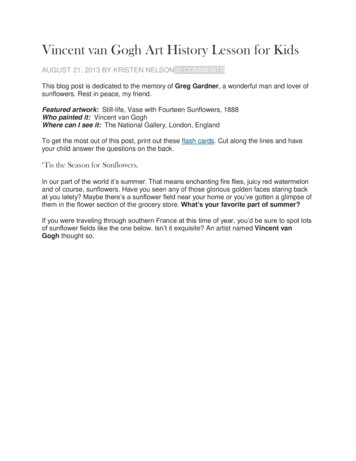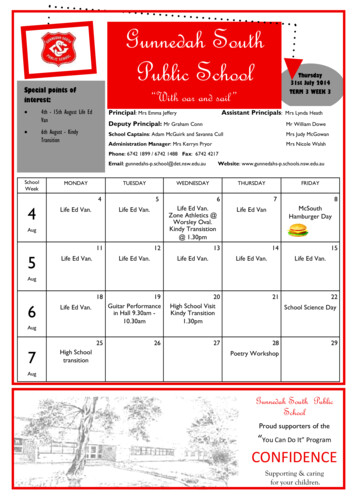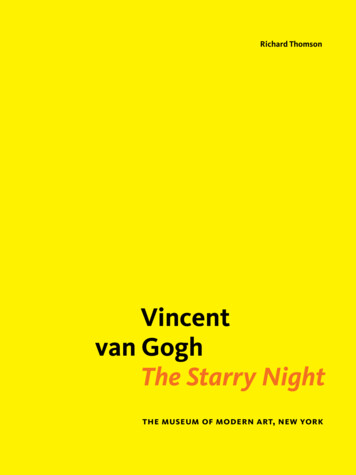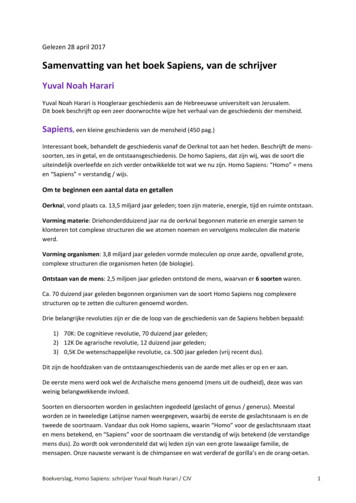
Transcription
Vincent van Gogh Art History Lesson for KidsAUGUST 21, 2013 BY KRISTEN NELSON30 COMMENTSThis blog post is dedicated to the memory of Greg Gardner, a wonderful man and lover ofsunflowers. Rest in peace, my friend.Featured artwork: Still-life, Vase with Fourteen Sunflowers, 1888Who painted it: Vincent van GoghWhere can I see it: The National Gallery, London, EnglandTo get the most out of this post, print out these flash cards. Cut along the lines and haveyour child answer the questions on the back.‘Tis the Season for Sunflowers.In our part of the world it’s summer. That means enchanting fire flies, juicy red watermelonand of course, sunflowers. Have you seen any of those glorious golden faces staring backat you lately? Maybe there’s a sunflower field near your home or you’ve gotten a glimpse ofthem in the flower section of the grocery store. What’s your favorite part of summer?If you were traveling through southern France at this time of year, you’d be sure to spot lotsof sunflower fields like the one below. Isn’t it exquisite? An artist named Vincent vanGogh thought so.
An Artist’s Hospitality.Vincent van Gogh was born in the Netherlands in 1853, but he spent part of his lifein France, studying the work of other artists and painting pictures. In the year 1888 he wasliving in the south of France in a town called Arles. It’s pronounced Arl. Can you locateit on the map below?
It was August. Vincent didn’t have any friends in Arles and was very lonely. He decided toinvite a fellow artist, Paul Gauguin, to come and stay with him so they could paint together.Paul accepted his invitation. Below is Vincent’s painting of the little yellow house where thetwo men collaborated. Sadly, you can’t visit the house today because it was severelydamaged by a bomb during World War II.
The Yellow House, 1988, Van Gogh Museum, Amsterdam. Image attributed toWikiPaintings.When friends or relatives are coming for a visit, how do you prepare for theirarrival? Do you help your parents clean the house and get the guest room ready? Ormaybe you make special cards or artwork to welcome them?Vincent wanted his friend Paul to feel welcome, and he wanted to impress him with his skillas a painter. So he created four sunflower still-lifes to decorate the walls of Paul’s bedroom.Here is what Paul saw upon entering his room.
Sunflowers, first version: turquoise background, private collection. Sunflowers, secondversion: royal-blue background, formerly private collection, Japan, destroyed by fire inWorld War II. Images attributed to WikiPaintings.
Sunflowers, third version: blue green background, Neue Pinakothek, Munich, Germany.Sunflowers, fourth version: yellow background, National Gallery, London, England. Imagesattributed to WikiPaintings.Paul Gauguin wasn’t very fond of the sunflower paintings and immediately removed themfrom the wall. Little did he know that a hundred years later one of Vincent’s sunflowerpaintings would sell for 40 million U.S. dollars! (Today, you could buy a jet for 40 milliondollars ) When it sold, it set a record for the most expensive painting in the world. I like tothink that on that day Vincent was up in heaven saying “nah nanny boo boo” to Paul.What is a still-life? A still-life is a painting or drawing of an arrangement of objects. Thesubject may have deep meaning and symbolism. For example, some still-lifes depicthourglasses, skulls or candles which are symbollic of mortality or the passing of time.Flowers and fruits from different seasons may represent nature’s cycle.Why do you think Vincent chose sunflowers as his subject?It might have been because Paul had acquired two of Vincent’s earlier sunflower paintingswhen they first met in Paris two years prior to their time in Arles. See below one of the twoVincent van Gogh paintings that belonged to Paul Gauguin.
Sunflowers, Kröller-Müller Museum, Otterlo. Image attributed to WikiPaintings.How is this painting of sunflowers laying on a table different than those Vincent painted in avase? Notice that the sunflowers Vincent painted in Arles are brighter and include manyshades of yellow. The use of vibrant colors was very popular at that time. During this period,there were innovations in pigment manufacturing, allowing artists like Vincent to use colorsnever seen before such as chrome yellow.So, what is a pigment? A pigment is a powder, which when mixed with liquid becomes apaint or ink.Chrome yellow is also the color of something you might ride in twice a day during the schoolyear – the American school bus!
Paul Gauguin painted the picture above. It depicts Vincent painting his beloved sunflowers.Although Gauguin didn’t think much of his sunflowers, Vincent himself was very pleasedwith them. Here’s how the artist described the paintings in a letter to his brother, Theo:‘’It has the effect of a piece of cloth with satin and gold embroidery; it is magnificent.”A Lasting ImpressionAnother reason Vincent used bright colors is that he was influenced by an art movementcalledImpressionism, prevalent during the 1870’s and 1880’s in Paris. Impressionist artists used a vividrange of colors that they applied in an unfinished, sketch-like manner. The Impressionists chose modernlife as their subject matter. In an Impressionist painting one may see people doing everyday things suchas having a picnic or playing the piano.
Berthe Morisot, Reading, 1873, Cleveland Museum of Art. Image attributed toWikiPaintings.Above is an Impressionist painting of a woman reading outdoors. Do you see the greenribbon cascading down her shoulder? Doesn’t it look like the painter, Berthe Morisot,created it in one, quickly-applied brush stroke? Notice also two items beside her by whichshe might cool herself on a warm summer day. What are they? Her facial features are notclearly defined because the artist wanted only to give an impression of them.Vincent and Paul were part of a group of artists known today as the Post-Impressionists.Their work succeeded the Impressionists and used similar, bright, non-traditional colors.The Post-Impressionists, however, wanted to create art with a deeper meaning and aimedto express and elicit emotion through their paintings. Vincent explained his technique to hisbrother in a letter:“Instead of trying to accurately render what is before my eyes, I use color more arbitrarily, toexpress myself more powerfully.”The Post-Impressionists didn’t paint things exactly how they appear in real life, but usedartistic freedom to depict subject matter in a personal, more abstract way.
Let’s take a closer look at one of Vincent’s sunflower paintings. What do you feel whenyou look at this image? Notice how some of the flowers appear freshly cut and othersseem to have been sitting around the house for a few days. Vincent wanted to capture themin all different stages of life. A few of the flowers are looking straight at you while some ofthem turn their heads away.Can you point to where Vincent signed the painting? When signing works of art, mostpeople use their last name. For example Pablo Picasso always signed his paintings“Picasso.” Vincent was different and consistently used his first name only. This wasbecause he felt rejected and misunderstood by his family and therefore preferred not to usetheir name.
Sadly, Vincent van Gogh remained an isolated and misunderstood person most of his shortlife. He suffered from a mental and physical illness for which there was no treatment at thattime. Aside from his brother Theo, Vincent didn’t have many friends.Have you ever been in a field of sunflowers? They are beautiful. They are also big andsturdy. Even though Vincent was unhappy, unsuccessful and unhealthy, I think of him as asunflower; lovely and strong.Paul Gauguin only stayed in Arles for four short months. After he left, Vincent checkedhimself into an asylum which was a place where people went when they were sick andneeded help. Vincent eventually left the asylum and died two years later. He was 37 yearsold and had only been painting for nine years. In that short time he completed over 900paintings. Although he sold only one of them during his lifetime, Vincent is today one of themost well-loved artists of all time.Fun Facts:1. Paul Gauguin painted his pictures from memory,however Vincent preferred to paint his subjects whilelooking at them.2. Do your parents drink coffee in the morning in order to wakeup?Vincent would rise early each day and drink lots ofstrong, dark coffee. Once he was energetic from all the
caffeine, he’d start working. Can’t you imagine him, palette inhand, excitedly dabbing his brush in fresh yellow paint andcoating the canvas in thick, blazing brush-strokes?3. Vincent often didn’t mix his paints, but used them straightfrom the tube. If you look closely, you can see his brush-strokes,which are so lively they appear to be dancing!4. Paul Gauguin may have taken Vincent’s sunflower paintingsdown from the wall but he loved the actual flowers. Paulbrought some sunflowers with him to the island of Tahiti,where he liked to paint, so they could grow there as well.What’s happening?What was going on around the world in 1888 while Vincent van Gogh was paintingsunflowers in southern France?
1. Theodore “Teddy” Roosevelt, who would become the 26thPresident of the United States, turned one year old. The TeddyBear was given its official name in his honor.2. Kodak offered their first camera for sale. It was priced at 25and came with enough film for 100 pictures.3. Queen Victoria and her husband Albert were regents of theUnited Kingdom. To this day Victoria is the longest ruling femalemonarch in history.What have you learned?
Questions for preschoolers:1. What colors and shapes do you see in this painting?2. If you could smell the flowers, what would they smell like?3. What type of flowers are in the vase and how many are there?Questions for elementary school-aged children:1. In what city did Vincent van Gogh paint his famous sunflowers?In what country is this city located?2. What was the period of art in which Vincent worked? Whatperiod of art did it follow?3. What color did Vincent use that was somewhat new in the late19th century?Questions for children ages 12 and above, requiring further exploration:1. How was Post-Impressionism different from its predecessor,Impressionism?2. What are some names of other Post-Impressionists?3. List three adjectives to describe Vincent van Gogh’s style ofpainting.4. How did Vincent van Gogh sign his paintings and why?5. Name two products you can find in the grocery store that comefrom the mvincent-van-gogh/
Vincent van Gogh Art History Lesson for Kids AUGUST 21, 2013 BY KRISTEN NELSON30 COMMENTS This blog post is dedicated to the memory of Greg Gardner, a wonderful man and lover of sunflowers. Rest in peace, my friend. Featured artwork: Still-life, Vase with Fourteen Sunflowers, 1888 Who painted it: Vincent van Gogh










